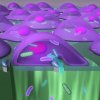Injecting large molecules and even bacteria into the interior of mammalian cells has been a challenging and slow process. It takes about one minute by conventional methods to inject one cell, but researchers at UCLA have developed a device that can do the same at an astonishing rate of 100,000 per minute.
While traditional techniques use tiny syringe-like pipettes, the new system, called biophotonic laser-assisted surgery tool (BLAST), uses a totally different approach. Cells are positioned on top of a silicon chip that has a large number of tiny holes throughout. The titanium coating of the chip is heated up using a laser, causing liquid below the holes to bubble and propel into the cell membrane, causing a small rupture. This happens in a tiny fraction of a second, letting particles within the liquid below the holes to enter the cells.
The platform delivers large items including bacteria, enzymes, antibodies and nanoparticles into diverse cell types with high efficiency and cell viability. We used this platform to explore the intracellular lifestyle ofFrancisella novicida and discovered that the iglC gene is unexpectedly required for intracellular replication even after phagosome escape into the cell cytosol.
Source:Nature Method
New Device Delivers Thousands of Large Molecules Into Cells

